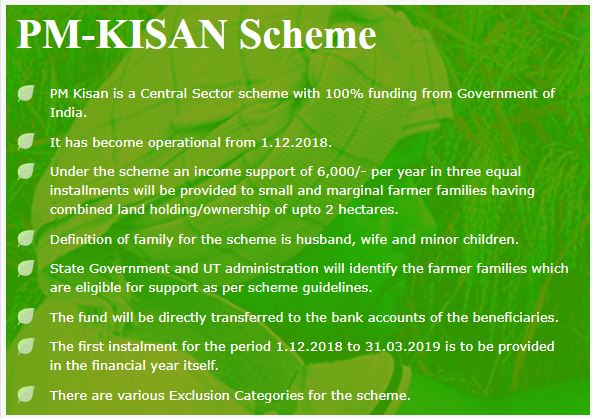Agriculture
PM-KISAN
- 03 Aug 2020
- 8 min read
This article is based on ‘‘PM-KISAN is not reaching all farmer households as intended” which was published in The Indian Express on 03/08/2020. It talks about the significance and challenges associated with PM-KISAN
The Pradhan Mantri Kisan Samman Nidhi (PM-KISAN) is the first universal basic income-type of scheme targeted towards farmers. Initially, the scheme was targeted at small and medium farmers, but with the declining growth in gross value added of the agricultural sector, it was extended to all farmers in May 2019.
The scheme aims to provide income support to farmers for easing their liquidity needs to facilitate timely access to inputs.
Various studies show that the scheme has significantly helped those who are relatively more dependent on agriculture and have poor access to credit. Nearly, 93% of non-beneficiary farmers had already applied for the scheme, depicting awareness and potential uptake.
Though the scheme directly or indirectly helps over 50% of the workforce, still a lot needs to be done to realize the dream of doubling the farmer’s income by 2022.
Twin Factors Aiding Success of PM-KISAN
- Enabling Direct Transfers to Farmers: Direct benefit transfer is now possible, as banking infrastructure created through Pradhan Mantri Jan Dhan Yojana (PMJDY) plays a key role in the fund disbursal.
- Digitization of Records: State governments have digitised the complete database of farmers who were now registered in the system with their credentials.
- The significant efforts made by the government machinery have revolutionized the welfare framework.
Advantages of PM-KISAN
- Easing Liquidity Constraints: India, more than half of the farming households do not have access to formal credit.
- In such a situation, PM-KISAN eases liquidity constraints of farmers for procuring inputs.
- This is extremely pertinent in India, as more than 50% farmers rely on informal credit and one-fifth farmers purchase inputs on credit.
- Producer support in India is very low compared to the other countries and the scheme will help in supplementing that.
- Aiding Modernisation: While the scheme is pitched as a general cash transfer scheme for the farmers, its role in the adoption of modern technologies remains an important contributing factor in modernization of agriculture.
- Moreover, the scheme has significantly stimulated the Krishi Vigyan Kendra's impact on the adoption of modern cultivars.
- Turning Farmers Competitive: Cash transfer increases the net income of farmers and thus, in turn, may enhance farmers’ risks-taking capacity, leading to undertaking riskier but comparatively productive investments.
- Non-Discriminatory in Nature: There is no selection bias in choosing the PM-KISAN beneficiaries based on attributes like caste and land size.
Issues That Needs To Be Addressed
- Ad-hocism: Ad-hoc export and import policies, lack of infrastructure, and uncertainty in agricultural markets have adversely affected agricultural productivity and stability of farm incomes.
- Inadequate Support: The merit of cash transfers over loan waivers and subsidies lies in their potential greater efficiency in enabling poor households to directly purchase the required goods and services as well as enhance their market choices.
- Given that India’s poverty line is ₹32 per person per day in rural areas and ₹47 in urban areas, according to the Rangarajan Committee, the income support of ₹17 a day for a household, which is the amount offered by PM-KISAN, is largely insufficient for even bare minimum sustenance of vulnerable farmers.
- Volatility of Markets: Due to the volatile market and price fluctuations in different regions, it is important to index the cash transfers to local inflation.
- Also, the failure of Direct Benefit Transfer in kerosene in Rajasthan is a case in point, where the cash transferred to families has been insufficient to purchase kerosene, as the market price increased substantially.
- Lack of Grievance Redressal Mechanism: The scheme does not provide a clear design of transfers and a framework for effective grievance redress.
- For example, in the Mahatma Gandhi National Rural Employment Guarantee Scheme (MGNREGA), for instance, State governments still struggle to resolve complaints and curb corruption.
Way Forward
- Raising Economic Support: The impact of a welfare measure such as PM-KISAN can only be realised through financial support that provides farmers with adequate purchasing power to meet their daily basic necessities.
- Therefore, to be effective, any cash transfer scheme should first ensure that there is enough cash provided to help bring an affected community out of poverty.
- For instance, the Rythu Bandhu in Telangana provides ₹4,000 per acre to each farmer in each season, and the Krushak Assistance for Livelihood and Income Augmentation scheme (KALIA) in Odisha offers a direct cash transfer of ₹5,000 for a farm family over five seasons, among other benefits.
- Technology Choices for Farmers: It is realised that the adoption of technology for resolving liquidity issues is just one cog in the wheel.
- Knowledge and extension support is also needed to bring about adoption.
- Investing more in agricultural advisory services, the government can encourage farmers to invest some or all part of the income support in productive assets for achieving the multiplier effect of PM-KISAN.
- Back-end Support: The scheme needs back-end infrastructure and institutions in place to be effective.
- Adoption of modern technologies is one of the most promising strategies to increase farm incomes.
- Also, an alternative bottom-up strategy and well-planned implementation mechanism should be identified and implemented at the local level.
- The most effective modalities can then be scaled nationally and ensure success.
Conclusion
A direct transfer scheme like PM-KISAN is a game-changer and can have significant effects if it is timely, not transaction cost heavy and is provided with complementary inputs such as extension services.
| Drishti Mains Question PM-KISAN has the potential to break the cycle of intergenerational poverty and low income of farmers. Discuss. |





